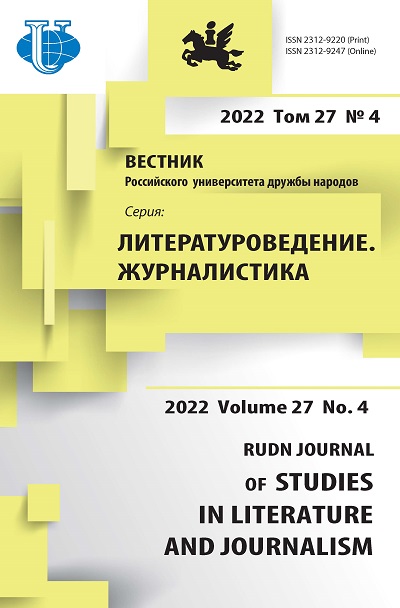Гиноцентризм в избранных поэтических произведениях Лэнгстона Хьюза
- Авторы: Пратап Чандран Р.1, Кумаресан П.1
-
Учреждения:
- Судхарсанский колледж искусств и наук, филиал Университета Бхаратидасан
- Выпуск: Том 27, № 4 (2022)
- Страницы: 716-725
- Раздел: Литературоведение
- URL: https://journals.rudn.ru/literary-criticism/article/view/33283
- DOI: https://doi.org/10.22363/2312-9220-2022-27-4-716-725
- ID: 33283
Цитировать
Полный текст
Аннотация
Гиноцентризм исключительно фокусируется на женщинах как в теории, так и на практике. Гиноцентрическим можно считать все, что касается исключительно женской точки зрения. Исследуются работы Лэнгстона Хьюза, в которых отражается пересечение рас и полов в жизни чернокожих. Его вклад принимает различные формы, включая поэзию, рассказы, драмы и романы о любви чернокожих женщин, природе, романтических дилеммах, отношениях матери и дочери, дружбе и молчании. Анализируется, как пол особенным образом окрашивает женскую идентичность в произведениях Хьюза. В своем представлении о чернокожих женщинах он рассматривает взаимозависимость полов и расовой идентичности и, следовательно, его взгляд может быть назван гендерно-расовым. Произведения, написанные в гендерно-расовом стиле, подчеркивают и переплетают гендерную и расовую идентичность. Хьюз преодолевает гендерные и расовые стереотипы с помощью открытых дискуссий на спорные темы. Делается вывод, что Хьюз создает альтернативу репрессивным социальным реалиям, сочетая вызовы с чувственными видениями.
Ключевые слова
Об авторах
Р. Пратап Чандран
Судхарсанский колледж искусств и наук, филиал Университета Бхаратидасан
Автор, ответственный за переписку.
Email: prathapcdc@gmail.com
ученый-исследователь, исследовательский отдел английского языка Тиручираппалли, Перуманаду, Пудуккоттай, Тамилнаду, Республика Индия
П. Кумаресан
Судхарсанский колледж искусств и наук, филиал Университета Бхаратидасан
Email: drpkenglish@gmail.com
доктор, адъюнкт-профессор английского языка Тиручираппалли, Перуманаду, Пудуккоттай, Тамилнаду, Республика Индия
Список литературы
- Anderson, J. (2013). Langston Hughes. ABDO Publishers.
- Best, W. (2017). Langston’s salvation: American religion and the bard of Harlem. New York University Press.
- Bloom, H. (2002). Langston Hughes. Chelsea House Publishers.
- Carr, D. (2016). She voices them: Evidence of black feminism in black women’s Harlem renaissance literature. CUNY Academic Works.
- De Santis, C. (2005). Langston Hughes: A documentary volume. Thomson, Gale Publishers.
- Farebrother, R. (2016). The collage aesthetic in the Harlem renaissance. Routledge.
- Gale, C.L. (2016). A study guide for Langston Hughes’s “Theme for English B.” Gale, Cengage Learning.
- Gutkin, D. (2015). American opera, jazz, and historical consciousness, 1924-1994. Columbia University Press.
- Hoffman, T. (2013). American poetry in performance: From Walt Whitman to hip hop. University of Michigan Press.
- Hughes, L. (1940; 1993). The big sea. New York: Knopf, Hill and Wang.
- Hughes, L., & Rampersad, A. (2002). The poems, 1941-1950. University of Missouri Press.
- Kirszner, L., & Mandell, S. (2017). Compact literature: Reading, reacting, writing. Cengage Learning.
- Kutzinski, V. (2012). The worlds of Langston Hughes. Cornell University Press.
- Miller, R. (2015). Baxter, black American literature and humanism. University Press of Kentucky.
- Mphahlele, E. (1972). Variations on a theme: Race and color. Présence Africaine, 3, 92-104.
- Opdycke, S. (2016). The WPA: Creating jobs and hope in the Great Depression. Routledge.
- Rampersad, A. (2002). The life of Langston Hughes. Vol. I. 1902-1941. Oxford University Press.
- Sears, J.T. (2014). Growing up gay in the south: Race, gender, and journeys of the spirit. Taylor and Francis.
- Wallace, M. (2007). Langston Hughes: The Harlem renaissance. Marshall Cavendish Benchmark.
- Wei, X. (2010). Use of dreams in Hughes’s poetry. Canadian Social Science, 3(5), 128-133.
Дополнительные файлы















